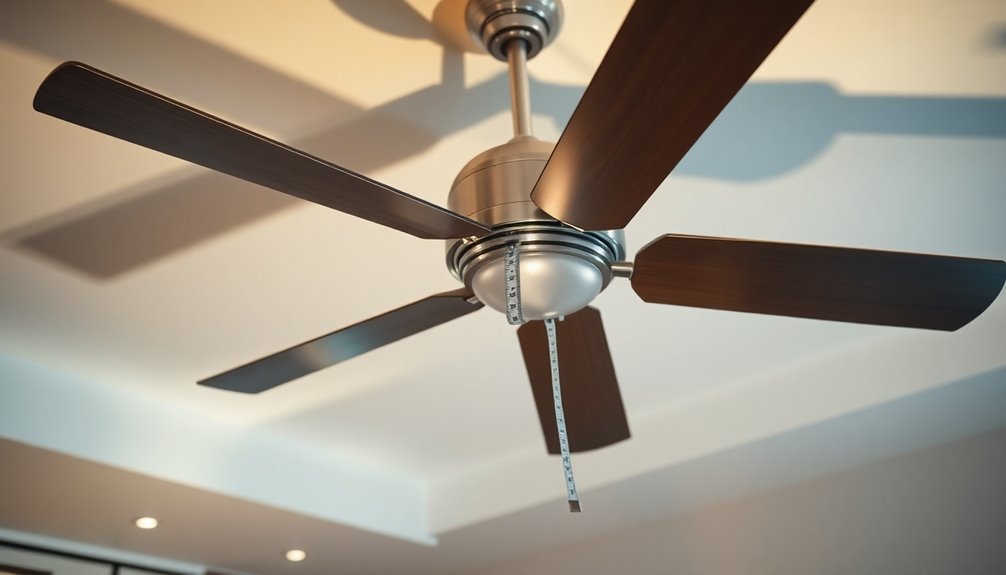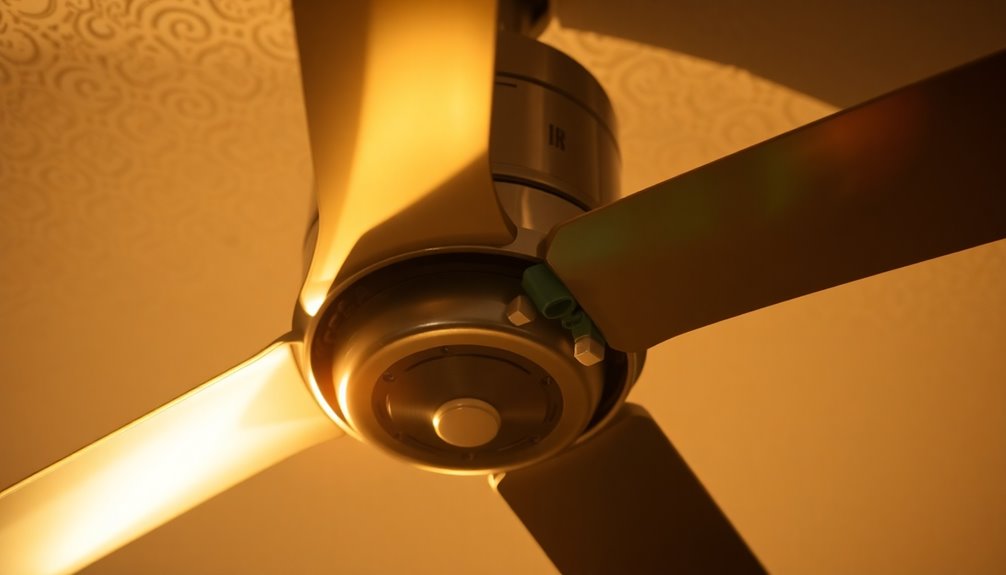If your ceiling fan light flickers, it could be due to several issues. Loose wire connections or poorly fitted bulbs often cause this annoyance. Additionally, incompatible dimmer switches or issues with the circuit can contribute to flickering. Bulb type matters too; LED and CFLs may not work well with certain dimmers. You might also notice flickering alongside high-demand appliances, suggesting overloaded circuits. Regular maintenance, checking for loose connections, and ensuring compatibility can help. There's more you can explore about resolving these flickering light problems effectively.
Key Takeaways
- Loose wiring connections in the ceiling fan assembly can disrupt power flow, causing flickering lights.
- Incompatible dimmer switches with CFL or LED bulbs often lead to flickering issues.
- Overloaded circuits from high-demand appliances may result in intermittent flickering of ceiling fan lights.
- Regularly check and tighten light bulbs, as vibrations can loosen connections and cause flickering.
- Persistent flickering might signal faulty wiring or voltage fluctuations, necessitating professional evaluation.
Common Causes of Flickering Lights

Flickering lights can be frustrating, and there are several common causes you should consider. One of the most frequent culprits is a loose wire or a poorly connected bulb. If your ceiling fan vibrates, it can disrupt the connection, causing the light to flicker. Confirm the bulbs are securely tightened in their sockets.
Another potential issue comes from dimmer switches that aren't compatible with certain bulb types, especially CFL and LED. If you've recently switched to these more energy-efficient options, check if your dimmer switch is suitable.
Faulty wall switches can also degrade over time, affecting the electrical flow and leading to intermittent flickering.
You might also experience light flickers due to voltage fluctuations in your circuit. If you're running multiple devices simultaneously, the demand for power can cause lights to dim or flicker.
Finally, if your ceiling fan has a remote control, verify the batteries are in good condition. Interference from other devices can also disrupt the signal, causing temporary flickering.
Identifying these common causes can help you troubleshoot the issue effectively.
Electrical Component Issues

When troubleshooting flickering lights in your ceiling fan, it's important to examine the condition of various electrical components. Loose wiring connections within the ceiling fan assembly can disrupt power flow, leading to those annoying flickers in your light fixture.
If you notice intermittent flickering, it might indicate voltage fluctuations in the electrical circuit, signaling that an inspection is necessary.
Faulty switches can also be culprits; they may degrade over time and fail to maintain a stable electrical connection, resulting in flickering lights.
Additionally, issues with the circuit board can interrupt power delivery, causing inconsistent illumination in your ceiling fan.
If the connections are overheating due to inadequate electrical flow, this can create temporary failures that further contribute to flickering.
Bulb Types and Compatibility

When you're choosing bulbs for your ceiling fan, it's essential to take into account compatibility.
Using the wrong type, especially with dimmers, can lead to flickering or inconsistent lighting.
Make certain to match the recommended bulb types and wattages to guarantee smooth operation and peak performance.
Bulb Compatibility Issues
Understanding bulb compatibility is crucial for maintaining a consistent lighting experience in your ceiling fan. If you're using LED bulbs, you'll want to verify they're paired with compatible dimmers, as incompatible options can lead to flickering.
Similarly, compact fluorescent lamps (CFLs) may also flicker when used with mismatched dimmer switches, since they require specific types to perform at their best.
Incandescent bulbs tend to be more reliable, but they can still flicker if they're not securely fitted or if their wattage exceeds what your fan can handle.
Mixing different bulb types in the same fixture can create additional bulb compatibility issues. For example, combining LED and incandescent bulbs may lead to inconsistent lighting behavior due to their different electrical characteristics.
To minimize flickering issues, always check that the wattage and type of bulb match the manufacturer's recommendations for your ceiling fan.
Dimming Functionality Considerations
Properly managing the dimming functionality of your ceiling fan's lighting involves more than just choosing the right bulbs. It's crucial to verify that your dimmable bulbs are compatible with your dimmer switch. Using incompatible combinations can lead to flickering, especially with LED lights, which often need specific dimmers designed for their low wattage. Incandescent bulbs are generally more forgiving, but mixing different types, like LED and incandescent, can create inconsistent lighting behavior.
Here's a quick reference table to help you understand bulb compatibility:
| Bulb Type | Compatibility with Dimmers | Flickering Risk |
|---|---|---|
| LED Light | Needs compatible dimmer | High if not matched |
| Incandescent | Generally compatible | Low, more forgiving |
| Fluorescent | Needs specific dimmer | High in low temperatures |
| Dimmable LED | Must match wattage | Medium if mismatched |
| Mixed Bulbs | Avoid mixing types | High risk of flickering |
Recommended Bulb Types
Choosing the right bulb type for your ceiling fan is vital for ideal performance and to reduce flickering. LED light bulbs are often the best choice, as they tend to be less prone to flickering compared to incandescent bulbs. When selecting bulbs, make sure they match your ceiling fan's specifications. Mismatched wattage or incompatible bulb types can lead to overheating and flickering issues.
If you consider using CFL bulbs, be cautious. They may flicker with incompatible dimmer switches, so it's important to choose the right dimmer for your specific bulb type.
While incandescent bulbs are reliable, they can still flicker if they're not securely installed. Always check your fittings to make certain they're tight.
It's also significant to avoid mixing different bulb types in your ceiling fan. Doing so can lead to inconsistent lighting behavior and increased flickering. For the best results, stick with uniform bulb types across your fan.
Troubleshooting Steps

If your ceiling fan light is flickering, it can be frustrating, but there are several straightforward troubleshooting steps you can take to resolve the issue.
First, check and tighten all bulb connections. Loose bulbs can easily cause a flickering light due to vibrations from the ceiling fan.
Next, inspect your wall switches for any signs of wear or damage. A faulty light switch may not maintain a stable connection, leading to flickering.
After that, test each bulb individually. Sometimes, a damaged or burnt-out bulb can contribute to inconsistent lighting performance. If you find a faulty bulb, replace it with a compatible one.
Additionally, examine the wiring connections within the fan. Loose or damaged wiring can disrupt power flow, causing flickering lights.
Lastly, verify that all components—bulbs and switches—are compatible with each other. Using incompatible parts can create electrical disturbances that result in flickering.
Maintenance and Prevention

Maintaining your ceiling fan light can make a big difference in preventing flickering issues. Start by regularly checking and tightening your light bulbs. Vibration from the fan can loosen them over time, leading to flickering. If you're using dimmable bulbs, upgrade to compatible dimmer switches, as incompatible ones can create instability in the lights' output.
Schedule periodic inspections of the fan's electrical components. This proactive maintenance helps identify any potential issues before they escalate into flickering problems. Always use bulbs recommended by the ceiling fan manufacturer to guarantee compatibility and peak performance. Using the right bulbs greatly reduces the likelihood of flickering.
Additionally, consider installing surge protectors to guard against electrical spikes. These spikes can cause your lights to flicker intermittently, disrupting your comfort.
By incorporating these maintenance practices, you'll enjoy a more stable and reliable ceiling fan light, free from flickering interruptions. Regular attention to these details not only enhances your lighting experience but also extends the lifespan of your ceiling fan.
Device Compatibility Concerns

Proper maintenance of your ceiling fan light isn't just about keeping bulbs tight and checking for electrical issues; it also involves understanding device compatibility.
When your light started flickering, it could be due to compatibility issues between aftermarket remote controls and low-current LED bulbs. Unlike incandescent bulbs, which generally work better with most remote controls, LED bulbs often need specific dimmers to operate smoothly.
Testing different bulb types, such as incandescent and CFL, can help you identify which ones work best with your ceiling fan setup. If you're using aftermarket components that don't meet the required specifications for LED usage, you may exacerbate flickering issues.
To minimize device compatibility concerns, verify all devices and controls are compatible with the type of bulbs you're using. This won't only reduce flickering but also enhance the overall performance of your ceiling fan lighting.
Impact of High-Demand Appliances

When high-demand appliances operate, they can greatly impact your ceiling fan lights, often causing flickering. Devices like laser printers draw significant power, leading to voltage fluctuations in your lights circuit.
If you have several high-demand appliances running simultaneously on the same circuit, the increased load can exceed the circuit's capacity, resulting in intermittent flickering of your lights.
LED bulbs are especially sensitive to these voltage changes, making them more prone to flickering when high-demand appliances are active. If you're experiencing this issue, it's worthwhile to examine the devices connected to the same circuit.
Understanding their power requirements and load capabilities is essential for maintaining consistent lighting performance. Additionally, utilizing energy-efficient technology can help minimize the impact of these appliances on your lighting systems.
To mitigate flickering, consider redistributing your devices across different circuits or dedicating a separate circuit specifically for high-demand equipment.
This way, you can help stabilize the power flow and reduce the risk of flickering lights. By taking these steps, you can enhance your ceiling fan's lighting performance and create a more comfortable living environment.
Wiring and Circuit Considerations

Understanding your home's wiring and circuit layout is essential for preventing flickering in ceiling fan lights. If your residential wiring isn't designed to handle several high-demand devices, it can lead to insufficient power supply for your ceiling fan lights. This situation often results in flickering, especially if you're using LED lights, which are particularly sensitive to voltage fluctuations.
Standard circuits may not be equipped to manage the electrical load from modern appliances, causing voltage drops that disrupt the steady flow of power. You might notice that identical setups in different rooms behave differently; this is usually due to variations in wiring quality or circuit capacity.
To mitigate flickering issues, confirm your circuit design allows for proper load distribution. It's important to assess how many devices are connected to each circuit, as overloading a circuit can lead to inconsistent power supply.
When to Contact an Electrician

If your ceiling fan light flickers consistently after you've replaced the bulbs, it's time to contemplate contacting an electrician.
Frequent flickering, especially when using high-demand appliances, could signal underlying electrical issues that need professional attention. This is similar to how continuous monitoring of AI behavior is essential to identify potential problems. Additionally, poor indoor air quality caused by electrical issues can lead to various health concerns, emphasizing the importance of addressing electrical problems promptly.
Don't hesitate to seek help if you notice loose wiring or experience flickering in multiple lights around your home. Additionally, addressing any potential financial misconduct early on can help alleviate stress that may arise from unexpected costs related to electrical repairs.
Signs of Electrical Issues
Flickering lights in your ceiling fan can be a clear sign of underlying electrical issues that shouldn't be ignored. If you notice any of the following signs, it's time to contact an electrical contractor for a professional evaluation:
- Loose Connections: If the flickering persists after replacing bulbs or tightening connections, you might've loose wiring disrupting the power flow.
- Overloaded Circuits: When the flickering occurs alongside high-demand appliances, it could indicate overloaded circuits, which require circuit management.
- Signs of Overheating: Any signs of burning smells or visible damage in the fan or its wiring suggest deeper electrical issues that need immediate attention.
Don't wait until the problem escalates. If multiple light sources flicker simultaneously, this could indicate voltage fluctuations or circuit integrity issues, making it crucial to consult an electrician.
Frequent Flickering Symptoms
Experiencing frequent flickering in your ceiling fan lights can be frustrating and concerning. If you've already tried different bulbs—like switching to traditional incandescent or CFL options—and the flickering lights persist, it's a sign of deeper electrical issues that need professional evaluation.
Loose wiring connections might be disrupting power flow, and this requires immediate attention from a qualified electrician.
You should also consider that strobing or flashing behavior may result from faulty dimmer switches incompatible with LED bulbs. If that's the case, an electrician can help guarantee everything operates safely.
Additionally, overloaded circuits or voltage fluctuations caused by high-demand appliances can lead to flickering lights. This suggests you might need circuit management to address the issue properly.
If you notice flickering accompanied by buzzing noises or overheating fixtures, don't wait to contact an electrician. These symptoms can indicate serious problems that pose potential fire hazards or further electrical damage.
It's always better to err on the side of caution when it comes to electrical issues in your home.
When to Seek Help
Persistent flickering in your ceiling fan lights isn't just an annoyance; it often signals underlying electrical issues that shouldn't be ignored.
If you've tightened bulbs and checked switches but the flickering continues, it's time to seek professional help. Here are three key situations where contacting an electrician is essential:
- Frequent Flickering: If your lights often flicker or strobe, it could indicate faulty wiring or overloaded circuits. These issues can pose safety risks and require a licensed electrician's expertise.
- Other Electrical Problems: If you're also experiencing tripped circuit breakers or dimming lights when using appliances, it's wise to consult an electrician for a thorough evaluation.
- Incompatible Components: Outdated electrical components or incompatible dimmer switches can lead to flickering. An electrician can identify and upgrade these elements, ensuring your ceiling fan lights operate safely and efficiently.
If you're uncertain about inspecting electrical issues safely, don't attempt DIY fixes.
The potential hazards aren't worth the risk. Reach out to an electrician who's the necessary electrical experience to handle these concerns effectively.
Frequently Asked Questions
How Do You Fix a Flickering Ceiling Fan Light?
To fix a flickering ceiling fan light, start by checking and tightening all bulb connections.
Verify they're secure and properly fitted.
Next, inspect the fan's wiring for any looseness or damage.
If you're using dimmer switches, confirm they're compatible with your bulbs.
Try swapping in incandescent bulbs, which are generally more reliable.
If flickering continues, it might be time to call a licensed electrician to look for deeper electrical issues.
How Do You Fix a Flickering Ceiling Light?
To fix a flickering ceiling light, start by checking the bulb connections. Make certain they're tight and secure, as loose bulbs often cause flickering.
Next, inspect the wall switches for any wear or damage that might affect performance. Test each bulb individually to identify faulty ones, and replace any incompatible units.
Finally, examine the wiring connections to confirm they're secure. If the issue persists, consider consulting a licensed electrician for further help.
Why Do LED Lights Flicker in a Ceiling Fan?
You might notice your LED lights flickering in your ceiling fan, and it's more common than you'd think.
This could happen due to loose connections that get jarred by the fan's vibrations. Incompatible dimmer switches can also create instability, leading to flickering.
Additionally, voltage fluctuations when other appliances kick in can affect performance.
Make sure you're using quality bulbs rated for fans, and keep those connections tight to minimize the issue.
How Do I Stop My LED Lights From Flickering?
To stop your LED lights from flickering, start by ensuring compatibility with your dimmer switch, as incompatible ones can cause issues.
Check all bulb connections to make sure they're tight, which helps prevent flickering from vibrations.
Consider using LED bulbs specifically designed for ceiling fans and opt for high-quality options.
If flickering persists, installing a voltage regulator can help stabilize power supply and reduce fluctuations that contribute to the problem.
Conclusion
To sum up, if your ceiling fan light flickers, it's crucial to identify the cause before it leads to bigger issues. Have you checked if your bulbs are compatible or if there's a problem with the wiring? Regular maintenance can help prevent flickering and potential hazards. Don't ignore those flickers—addressing them early can save you time and money in the long run. If you're unsure, contacting an electrician is always a smart choice.









